The Results of my Startup School 2013 Notes experiment
The Startup School 2013 Notes are here:Â https://bitly.com/susnotes
Below, I reveal the story behind the Notes and the results of my experiment.
A Brief Summary of my Formative Years: The Connected Mobile Revolution
When I was 12, I was flipping through a tech magazine when I spotted the Cybiko. I became obsessed, eventually purchasing multiple Cybiko devices and learning BASIC and C in order to develop Cybiko apps and games. I spent countless hours involved in the nascent Cybiko Community; on April 21, 2001, I registered my first domain name: 4Cybiko.com (the site is long gone now). The Cybiko sparked my interest in wireless, collaborative computing and over the next few years, my passion for connecting mobile devices only grew. [1]
When the iPhone was released in 2007, I was an intern at Google Santa Monica. On launch day, I walked over to the Apple Store and stood in line for one hour to pick up the original iPhone. With 4 GB flash storage, a 2 MP camera, and $499 price point, it was by far the most powerful and expensive phone I’d ever owned. It replaced my Nokia flip phone. But the specs didn’t matter one iota. The real magic, to me, came from just three things: the massive touchscreen, the wireless capabilities, and the software.
I attended WWDC 2009 on a student scholarship. That year, I discovered the immense power of SubEthaEdit (SEE), a collaborative text editor for Mac. At that time, Google Docs didn’t support real-time collaboration, so SEE was truly a leap into the future. But most importantly — and this is something that Google Docs still doesn’t have today — it was easy to make documents public and easily discover nearby docs. At WWDC, the audience used it to collaboratively take notes on all of the sessions. This happened on an entirely grassroots basis: there was no official mention of it by Apple or anyone else.
And the notes that were produced were simply brilliant.
Since SEE is Mac-only, WWDC is one of those rare opportunities for it to truly reach critical mass. With SEE, I could see a glimpse of the future. Unfortunately, the developers of SEE never intended it to take it beyond the Mac, and it hasn’t been updated since 2011. [2]
I have a hypothesis: Improved collaborative notes will enable people to communicate more broadly, deeply, and effectively.
Google Docs partly fulfills my vision, but it’s missing several key components, the most important of which is discoverability. It’s already somewhat easy to take notes and make them public. But it should also be incredibly easy to find relevant notes that nearby people are creating.
That takes us to present day. Startup School 2013: Y Combinator’s annual event for hackers and other startup folks.
It was just past midnight the night before SUS2013 when I decided to make the Google Doc. It would be an experiment. A way to test my hypothesis.
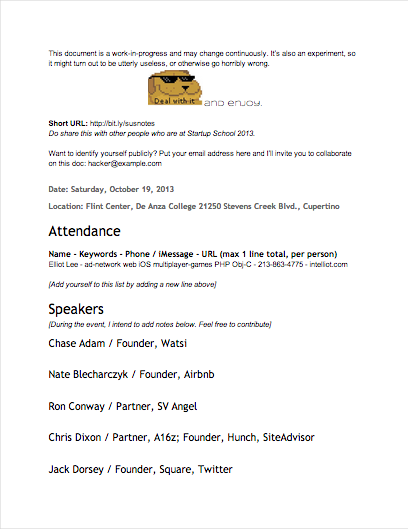
Startup School 2013 Notes — Revision #0
A key aspect of my experiment is that the doc would be world-writable. During Startup School, anyone could find the doc, view it, and edit any aspect of it. Every person in the world effectively had “admin” rights and could change anything they wanted. (Of course, Google Docs has a superb Revision history feature that makes this relatively safe.)
As an explainer, I wrote at the top: “This document is a work-in-progress and may change continuously. It’s also an experiment, so it might turn out to be utterly useless, or otherwise go horribly wrong.”
I also dropped in this meme:

Deal with it meme
I felt this would help set the tone of the experiment and encourage everyone to have fun. Life’s too short to be a downer, so even if people do things I don’t like, I’ll be the optimist and turn the other cheek.
To track click stats, I created a Short URL. You can view the stats for this link here:Â https://bitly.com/susnotes+
Did You Know? Appending “+” to the end of any bit.ly URL enables you to see the Short URL’s destination URL and also view some cool stats.
I posted the link on the Startup School 2013 Facebook group, which had about 800 members. I had no idea what proportion of the SUS2013 population that represented; I later learned that the event had around 1,700 attendees.
At the event, I met Paul Graham and told him about what I’d done.
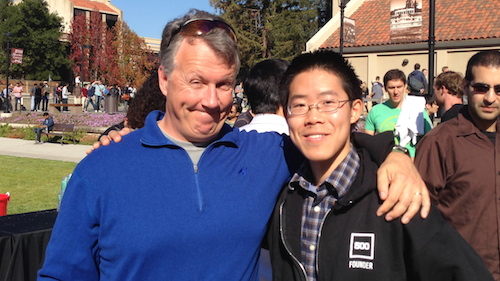
Paul Graham and Elliot Lee
He warned me that vandalism could be a problem. We discussed it for a bit. I told him that, with an audience like Startup School attendees, it’s not the same as something that the whole world is interested in. People are self-selecting and the people here are just plain awesome. [3]
A few dozen people had hopped on to my doc, though less than ten of them chose to publicly identify themselves. We were off.
Startup School is a firehose of information and stories, so it’s a pretty good use case for this kind of thing. One person, by him- or her-self, can’t take very good notes. But a few people, working together, can cover it pretty well; and also make it interesting by injecting some of their own personal biases. This isn’t an encyclopedia. There are no rules. Have at it!
Snag #1: An Accident Sends People to a Broken Link
At some point in the early afternoon, an anonymous user broke the Short URL by adding an extra letter to it. Whoops.
Other users pointed out that the URL was broken, and then it was removed altogether — all before I had a chance to even notice that it was broken!
I went back in the Revision history to investigate how it happened; then I copy and pasted the working link from a previous revision.
Not too bad. And I was impressed with the way other note-takers handled the issue before it even came to my attention.
Snag #2: I didn’t like the way someone was changing the document formatting
When I first created the doc, I had a vision in mind for how it should look: clean, simple, straightforward.
At 3:12 PM, an anonymous editor started making huge, sweeping, dramatic changes to the formatting of my doc. He shifted things around to be in a different order. He moved the “Deal with it” meme to the top left, tearing it apart from the context that I intially associated it with. He made “Welcome!” into a headline, and created a pseudo-two-column effect by putting lots of spaces between text on the left and right sides. He made Y Combinator’s Twitter URL and the #startupschool hashtag far more prominent, and added a couple links. The humble intro I had included at the top of the doc suddenly became labeled a “DISCLAIMER”.
I didn’t like it.
So I decided to try something: I changed the Sharing settings so that “Anyone on the Internet can find and comment” instead of “…find and edit“.
Instead of permitting the free-for-all, I’d manually add collaborators. They wouldn’t show up as anonymous on Google’s system. People who hadn’t been added yet could still add Comments, and thus interact with our little note-taking community.
Almost immediately, people started complaining!
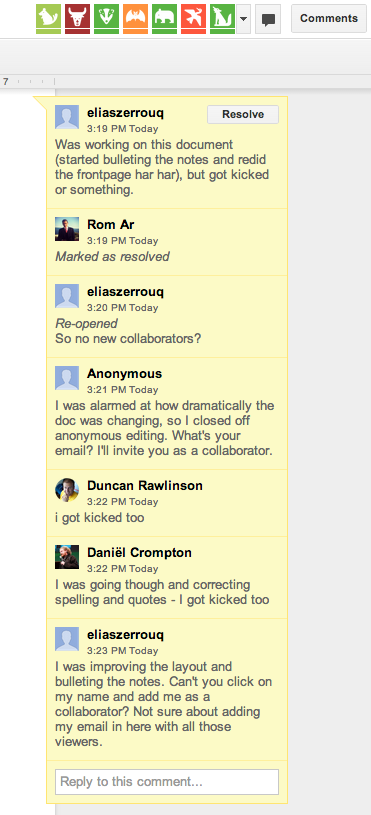
Complaints appear
I was fascinated. And after a little while, I realized that the formatting wasn’t so bad after all. It just wasn’t mine. But that’s not a good reason to dislike it.
So I re-opened access.
And nothing bad happened. In fact, the opposite occurred: the doc became even more fun and lively! At one point, we had nearly 10 people all editing the document simultaneously.
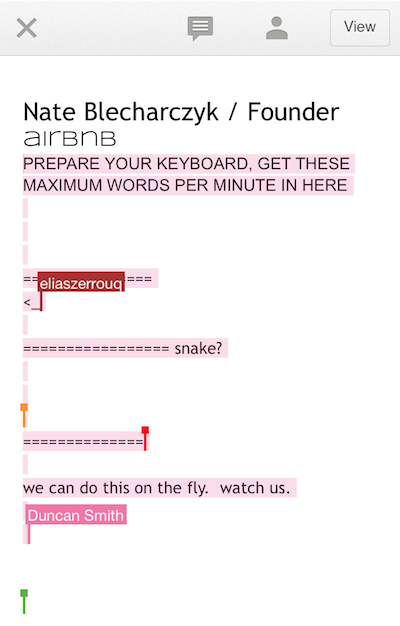
Random screenshot from my iPhone of attendees having fun
I had been trying to impose my own structure, but there was nothing particularly amazing about what I had initially laid out. So in this case, I learned to be even more open-minded. When people are given creative freedom, they may go in a direction that feels weird to me at first. But sometimes it can be good to run with it.
Surprise:Â Fun use of color
Someone with a bit of design sense went through and added the use of color in a few places.
This was neat and definitely not something I would have done myself.
Sidenote: I would LOVE to credit the person(s) who is behind these creative additions, but the Google Docs interface makes it prohibitively tedious and/or impossible to do a “blame” for individual changes. If anyone wants additional credit in this post, I’m more than happy to give it. Just let me know!
Here are some examples of cool stylistic elements that were added to the doc:

Styled twitter text
—
—

Chase Adam quote
—

Diane Greene quote
That’s not to say that all the notes were universally high-quality. In fact, some of it was hilariously bad. Arguably, some of what’s still in there right now is hilariously bad. But I think the quality is high enough that the content is still immensely useful.
In the end, my experiment succeeded. We created some great content, connected a community, and had a lot of fun doing it.
All around the world, there are thousands of missed opportunities every single day— simply because people don’t have the right tools that would enable them to discover, connect, and collaborate in real-time. Today’s wireless mobile devices are fully capable of realizing my vision, but the software just doesn’t exist yet.
Google Docs enables a rough “poor-man’s version” of what I really want, but it’s only halfway there. Discoverability is still hard. Actually USING the app, on an iPhone for example, is still hard. It’s not great on mobile and the offline support is still sketchy.
And– despite being operated by Google– it doesn’t yet scale quite far enough:
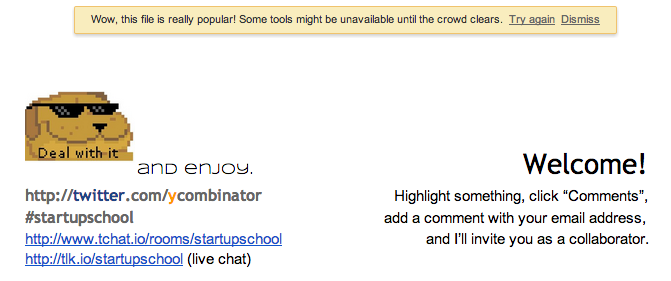
Some tools are unavailable
What did I miss in my experiment? Could this be the beginning of a larger trend in human interaction?
What’s Next
I’m the kind of entrepreneur who’s always bursting with 100 different ideas. I’m constantly refining, developing, and discussing them. And so far, I still don’t have enough people to discuss them with.
This post made a long story very short, and left out lots of details. I live in the Mission District of San Francisco. If you’re local, let’s meet up and hack. Here are high-level labels on a few of the ideas I’m kicking around or developing right now:
(1) Real-Time Mobile Collaboration
– My vision here is roughly a little bit like Twitter + Google Docs + mobile first.
(2) An Easy Ad Network for the Long Tail
– Clean ads for normal people.
(3) A mobile game that evolves, incessantly surprises players, and fosters a sense of community
– Updated remotely with new code deployed daily.
If you’ve made it this far, you might be exactly the hacker I want to meet. Get in touch! I’ve been on Twitter a good bit lately.
—
[1]Â Cybiko turned out to be a commercial failure. The next several years were the dark ages of mobile computing. I dabbled with everything from Palm to Pocket PC, and it was all crap. Disillusioned by lack of the mobile revolution I so desperately anticipated, I turned to web development while I was in high school and my first couple years of college at USC, where I studied Computer Engineering.
[2]Â So I was pretty excited when Google acquired EtherPad later that year, hoping that they’d take spontaneous collaborative note-taking to the next level. It took a couple years for them to get the technology integrated, but they eventually did it.
[3]Â If I wasn’t dependent on Google Docs, I’d add some simple moderation tools to discourage potential vandals, on an as-needed basis. But with Startup School attendees being so awesome, it’s really a very low priority. Don’t optimize too early.
Thanks to Robert Scoble for reading a draft of this.

Thanks a lot Elliot – it’s been a hefty work you shared with the crowd. Following the livestreaming around midnight our time (Dresden, Germany) and jotting down notes, as well as tweeting certainly showed myself, that it is more fulfilling to do it collaboratively!
Thanks for setting such an example!